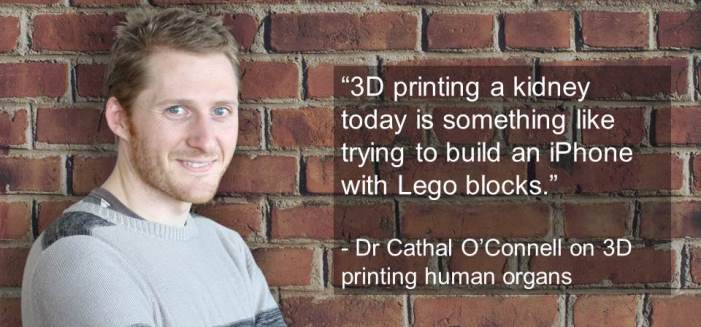News
3D printing bone tissue
Jun 28 2022
As a researcher in bioprinting (3D printing using living cells) one question I’m regularly asked is “Can you print organs?”

It’s a question that grabs people because, when we can print organs, there will be no such thing an organ donor list. Instead of waiting for a transplant, the patient will provide a small sample of cells and the hospital staff (not doctors or nurses, but a new breed of ‘biomedical engineers’) will grow up the cells to a large quantity, feed it into a bioprinter and print out a replacement organ. Because the organ will be made of the patient’s own cells, there will be no fear of rejection, and no need for immunosuppressant drugs. The whole procedure will take place in a matter of weeks.
Yeah but CAN you 3D print-organs?
The answer, more or less, is ‘no’. Though it really depends what you mean by ‘organ’.
Tissue engineers place the human organs on a scale of difficulty, depending on how easy they are to recreate in the lab. The easiest are flat structures, such as the skin—printed skin is probably not far off. Then come the hollow organs, such as the bladder—lab grown bladders were implanted in humans more than a decade ago, and 3D printed versions are on the way. Finally, the most difficult are the so called ‘solid organs’, such as the kidney or the liver.
The problem is the ‘solid organs’—the ones most in need—are phenomenally more complicated than the bladder.
Let’s take the kidney for example. 90% of people on US organ donor lists are waiting for kidneys; that’s over 120,000 people. Every year, the list gets longer but the number of transplants doesn’t budge. The ‘kidney donor gap’ widens and thousands die of a curable disease.
There are lots of reasons why current technology is not up to the task of printing a kidney. Whereas the bladder is made of just two main cell types, the kidney is made of 17. If you think about the cell types as different colours, at the moment, we’re only printing black and white.
The kidney also has a complex internal structure, such as the tiny, twisting, spaghetti like tubes called nephrons which filter the blood. Today’s bioprinters deposit big blobs of cells, and lack the fine resolution to create this kind of intricacy. Printing a kidney today is something like trying to build an iPhone with Lego blocks.
Finally, and perhaps most importantly, the solid organs require a sophisticated network of blood vessels throughout the structure. This is the household plumbing that keeps the cells fed with nutrients and carries away their waste. As we described in our recent eBook 3D Bioprinting: Printing Parts for Bodies, building a 3D structure by dropping cells on top of one another is like trying to build a wall out of water balloons. We don’t have the ability to build in the essential plumbing into the organ’s architecture. This is one of the biggest challenges in tissue engineering today.
OK so when will you be 3D-printing organs?
There is no well-defined roadmap, but it’s safe to say printed kidneys and livers are still probably a couple of decades into the future. But although printing organs is probably the grandest challenge of bioprinting, there are many more achievable goals along the way.
At ACES, we are using bioprinting to create scaffolds to be implanted in the body at the site of muscle or spinal cord injury. These structures are designed to make a ‘bridge’ for the muscle or the nerve to cross a previously impassable gap. They contain chemical or electrical cues to stimulate the body to regenerate itself, and they are made of smart materials which degrade naturally in the body, and can be safely excreted.
Even if we can’t print working organs yet, we can print human ‘proto-organs’- miniature facsimilies made of the correct cell type. Though lacking a complex vascular tree, these ‘organs on a chip’ could provide a new means to testing drug toxicity, potentially accelerating drug development and eliminating the need to test on animals.
One day in the not too distant future, there will be a bioprinting facility in every hospital. We will indeed print out spare parts for bodies. Just not yet.
It’s a big challenge, but that’s what makes it fun. And it will have a huge impact on people’s lives, that’s what makes it worthwhile.













